View in other NatureServe Network Field Guides
NatureServe
Montana
Utah
Wyoming
Idaho
Wisconsin
British Columbia
South Carolina
Yukon
California
New York
Northern Pikeminnow - Ptychocheilus oregonensis
State Rank Reason (see State Rank above)
Species is widely distributed but is declining and faces moderate threats
General Description
The predaceous Northern Pikeminnow is native to Montana west of the Continental Divide. It is somewhat pike-like in appearance with its large mouth and elongated body. Northern Pikeminnow prefer lakes and slow-moving waters. They are considered to be highly undesirable in some situations because they feed on young sport fish. They are effective predators despite their lack of teeth. Northern Pikeminnow are among the largest native North American minnows. Weights of over 7 pounds have been reported in Montana, with weights of nearly 30 pounds reported from Canada. Northern Pikeminnow are readily caught on bait, fly, or lure and put up a good fight but are poor table fare. (FWP) Generally 21-30 cm SL(length); may reach length of 63 cm and mass of 13 kg.
Diagnostic Characteristics
Back dark greenish, silvery below. Young have prominent dark spot at base of tail fin. No barbels.
Species Range
Montana Range
Range Descriptions
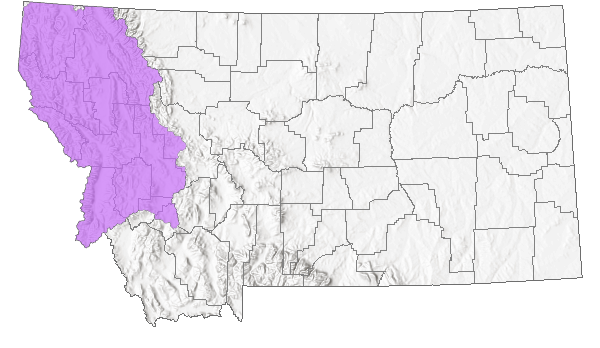
 Native
Native
Western Hemisphere Range
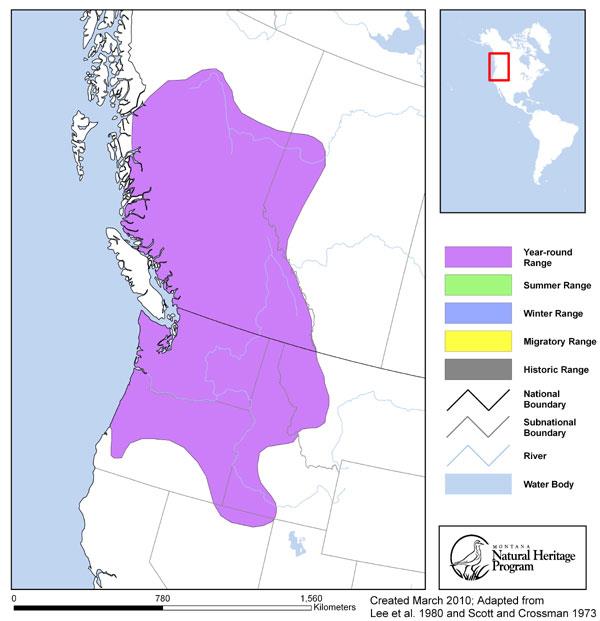
Observations in Montana Natural Heritage Program Database
Number of Observations: 2467
(Click on the following maps and charts to see full sized version)
Map Help and Descriptions
Relative Density
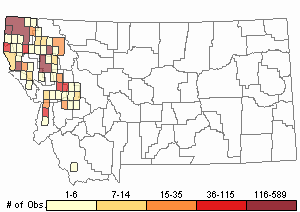
Recency
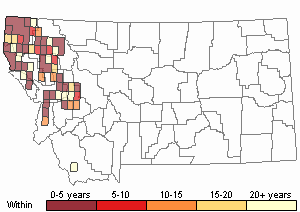
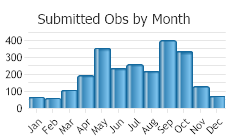
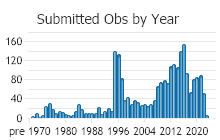
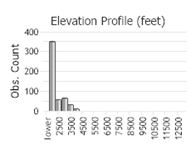 (Observations spanning multiple months or years are excluded from time charts)
(Observations spanning multiple months or years are excluded from time charts)
Migration
Some Northern Pikeminnow migrate from lakes into tributary streams to spawn.
Habitat
Prefers lakes and slow - flowing streams of moderate size. Young usually school in shallow water near lake shores and in quiet backwaters of streams (Weisel 1957, Brown 1971).
Food Habits
Most kinds of aquatic invertebrates. Adults frequently eat small fish. Considered a serious predator on young salmon and trout (Brown 1971, Gould personal communication).
Ecology
Has increased dramatically in Lake Koocanusa after Libby dam was built, but they may be decreasing in the river below the dam due to low spring water temperatures causing delayed spawing (May and Huston 1979, Huston et al. 1984).
Reproductive Characteristics
Sexually mature 5-6 yrs. Spawns May-early July over gravelly areas in streams or lakes. No patental care (Brown 1971, Weisel 1957). Spawned late May-early June at 55-65 degrees F. in Blackfoot River study (Hill 1958).
Stewardship Responsibility
References
- Literature Cited AboveLegend:
 View Online Publication
View Online Publication Brown, C.J.D. 1971. Fishes of Montana. Bozeman, MT: Big Sky Books/Montana State University. 207 p.
Brown, C.J.D. 1971. Fishes of Montana. Bozeman, MT: Big Sky Books/Montana State University. 207 p. Hill, C.W. 1958. Observations on the life histories of the Columbia River chub and Columbia squawfish in western Montana. M.Sc. Thesis. Bozeman, MT: Montana State University. 29 p.
Hill, C.W. 1958. Observations on the life histories of the Columbia River chub and Columbia squawfish in western Montana. M.Sc. Thesis. Bozeman, MT: Montana State University. 29 p. Huston J.E., P. Hamlin; B. May 1937-; Montana. Dept. of Fish, Wildlife, and Parks.; United States. Army. Corps of Engineers. Seattle District. 1984
Huston J.E., P. Hamlin; B. May 1937-; Montana. Dept. of Fish, Wildlife, and Parks.; United States. Army. Corps of Engineers. Seattle District. 1984 Lee, D.S., C.R. Gilbert, C.H. Hocutt, R.E. Jenkins, D. E. McAllister, J. R. Stauffer, Jr. 1980. Atlas of North American freshwater fishes. North Carolina State Musuem of Natural History. 867 p.
Lee, D.S., C.R. Gilbert, C.H. Hocutt, R.E. Jenkins, D. E. McAllister, J. R. Stauffer, Jr. 1980. Atlas of North American freshwater fishes. North Carolina State Musuem of Natural History. 867 p. May, B.E. and J.E. Huston. 1979. Status of fish populations in the Kootenai River below Libby dam. Montana Department of Fish, Wildlife, and Parks. 57 pp.
May, B.E. and J.E. Huston. 1979. Status of fish populations in the Kootenai River below Libby dam. Montana Department of Fish, Wildlife, and Parks. 57 pp. Scott, W.B. and E.J. Crossman. 1973. Rainbow trout, Kamloops trout, Steelhead trout Salmo gairdneri Richardson. pp. 184-191. In: Freshwater fishes of Canada. Ottawa, Canada: Fisheries Research Board of Canada, Bulletin 184. 966 p.
Scott, W.B. and E.J. Crossman. 1973. Rainbow trout, Kamloops trout, Steelhead trout Salmo gairdneri Richardson. pp. 184-191. In: Freshwater fishes of Canada. Ottawa, Canada: Fisheries Research Board of Canada, Bulletin 184. 966 p. Weisel, G.F. 1957. Fish guide for intermountain Montana. Montana State University Press. Missoula, MT. 88 pp.
Weisel, G.F. 1957. Fish guide for intermountain Montana. Montana State University Press. Missoula, MT. 88 pp.
- Additional ReferencesLegend:
 View Online Publication
View Online Publication
Do you know of a citation we're missing? Barnard, D. and J. Vashro. 1986. ASARCo Rock Creek project, baseline fisheries assessment. MTFWP Report under contract to ASARCo. 22 p.
Barnard, D. and J. Vashro. 1986. ASARCo Rock Creek project, baseline fisheries assessment. MTFWP Report under contract to ASARCo. 22 p. Brandt, Troy M. 2000. Fish diversity behavior and microhabitat use in secondary channels of the Bitterroot River, Montana. M.S. Thesis. University of Montana. Missoula, MT.
Brandt, Troy M. 2000. Fish diversity behavior and microhabitat use in secondary channels of the Bitterroot River, Montana. M.S. Thesis. University of Montana. Missoula, MT. Craig, V.E. 1952. A story of fish production as it applies to Montana. M.Sc. Thesis. Bozeman, MT: Montana State University. 92 p.
Craig, V.E. 1952. A story of fish production as it applies to Montana. M.Sc. Thesis. Bozeman, MT: Montana State University. 92 p. Dieterman, D.J., M.P. Ruggles, M.L. Wildhaber, and D.L. Galat (eds). 1996. Population structure and habitat use of benthic fishes along the Missouri and Lower Yellowstone Rivers. 1996 Annual report of Missouri River Benthic Fish Study PD-95-5832 to U.S. Army Corps of Engineers and U.S. Bureau of Reclamation. 238 p.
Dieterman, D.J., M.P. Ruggles, M.L. Wildhaber, and D.L. Galat (eds). 1996. Population structure and habitat use of benthic fishes along the Missouri and Lower Yellowstone Rivers. 1996 Annual report of Missouri River Benthic Fish Study PD-95-5832 to U.S. Army Corps of Engineers and U.S. Bureau of Reclamation. 238 p. Jones, Thomas S. 1991. Floodplain distribution of fishes of the Bitterroot River with emphasis on introduced populations of Northern Pike. M.S. Thesis. University of Montana. Missoula, MT.
Jones, Thomas S. 1991. Floodplain distribution of fishes of the Bitterroot River with emphasis on introduced populations of Northern Pike. M.S. Thesis. University of Montana. Missoula, MT. Joslin, Gayle, and Heidi B. Youmans. 1999. Effects of recreation on Rocky Mountain wildlife: a review for Montana. [Montana]: Montana Chapter of the Wildlife Society.
Joslin, Gayle, and Heidi B. Youmans. 1999. Effects of recreation on Rocky Mountain wildlife: a review for Montana. [Montana]: Montana Chapter of the Wildlife Society. Nelson, M.L. 1999. Evaluation of the potential for resident bull trout to reestablish the migratory life-form. M.Sc. Thesis. Bozeman, MT: Montana State University. 72 p.
Nelson, M.L. 1999. Evaluation of the potential for resident bull trout to reestablish the migratory life-form. M.Sc. Thesis. Bozeman, MT: Montana State University. 72 p. Noffsinger, Amy E. 1986. The functional morphology and feeding ecology of the Northern Pikeminnow (Ptychocheilus oregonensis)
Noffsinger, Amy E. 1986. The functional morphology and feeding ecology of the Northern Pikeminnow (Ptychocheilus oregonensis) Rahrer, J.F. 1963. Age and growth of four species of fish, Flathead Lake, Montana. M.Sc. Thesis. Bozeman, MT: Montana State University. 16 p.
Rahrer, J.F. 1963. Age and growth of four species of fish, Flathead Lake, Montana. M.Sc. Thesis. Bozeman, MT: Montana State University. 16 p. Rosapepe, J.V. 1991. Utility baits fish program with dollars. High Country News 23(19):5.
Rosapepe, J.V. 1991. Utility baits fish program with dollars. High Country News 23(19):5. Schultz, L.P. 1941. Fishes of Glacier National Park, Montana. USDI Conservation Bulletin No. 22. Washington D.C.: US Government Printing Office. 42 p.
Schultz, L.P. 1941. Fishes of Glacier National Park, Montana. USDI Conservation Bulletin No. 22. Washington D.C.: US Government Printing Office. 42 p. Sylvester, R. and B. Marotz. 2006. Evaluation of the Biological Effects of the Northwest Power Conservation Council's Mainstem Amendment on the Fisheries Upstream and Downstream of Hungry Horse and Libby Dams, Montana. Montana Fish, Wildlife, and Parks Annual Report prepared for U.S. Department of EnergyBonneville Power Administration. Bonneville Power Administration Project No. 2006-008-00 Contract No. 28350. 124 p.Contract No. 28350
Sylvester, R. and B. Marotz. 2006. Evaluation of the Biological Effects of the Northwest Power Conservation Council's Mainstem Amendment on the Fisheries Upstream and Downstream of Hungry Horse and Libby Dams, Montana. Montana Fish, Wildlife, and Parks Annual Report prepared for U.S. Department of EnergyBonneville Power Administration. Bonneville Power Administration Project No. 2006-008-00 Contract No. 28350. 124 p.Contract No. 28350 Sylvester, R. and B. Stephens. 2011. Evaluation of the physical and biological effects of the Northwest Power Conservation Council's Mainstem Amendment upstream and downstream of Libby Dam, Montana. Libby, MT: Montana Fish, Wildlife, and Parks Annual Report prepared for U.S. Department of Energy Bonneville Power Administration. Bonneville Power Administration Project No. 2006-008-00, Contract Nos. 43309 and 48555. 282 p.
Sylvester, R. and B. Stephens. 2011. Evaluation of the physical and biological effects of the Northwest Power Conservation Council's Mainstem Amendment upstream and downstream of Libby Dam, Montana. Libby, MT: Montana Fish, Wildlife, and Parks Annual Report prepared for U.S. Department of Energy Bonneville Power Administration. Bonneville Power Administration Project No. 2006-008-00, Contract Nos. 43309 and 48555. 282 p. Sylvester, R., A. Steed, J. Tohtz, and B. Marotz. 2008. Evaluation of the Biological Effects of the Northwest Power Conservation Council's Mainstem Amendment on the Fisheries Upstream and Downstream of Hungry Horse and Libby Dams, Montana. Montana Fish, Wildlife, and Parks Annual Report prepared for U.S. Department of EnergyBonneville Power Administration. Bonneville Power Administration Project No. 2006-008-00 Contract No. 28350. 124 p.Contract No. 28350
Sylvester, R., A. Steed, J. Tohtz, and B. Marotz. 2008. Evaluation of the Biological Effects of the Northwest Power Conservation Council's Mainstem Amendment on the Fisheries Upstream and Downstream of Hungry Horse and Libby Dams, Montana. Montana Fish, Wildlife, and Parks Annual Report prepared for U.S. Department of EnergyBonneville Power Administration. Bonneville Power Administration Project No. 2006-008-00 Contract No. 28350. 124 p.Contract No. 28350 Sylvester, R.M., B.C. Stephens, and J.T. Frye. 2014. Mainstem Columbia Amendments Research at Libby Dam - Evaluation of the Physical and Biological Effects of the Northwest Power Conservation Council's Mainstem Amendment Upstream and Downstream of Libby Dam, Montana. Libby, MT: Montana Fish, Wildlife, and Parks Annual Report prepared for U.S. Department of Energy Bonneville Power Administration. Bonneville Power Administration Project No. 2006-008-00. 461 p.
Sylvester, R.M., B.C. Stephens, and J.T. Frye. 2014. Mainstem Columbia Amendments Research at Libby Dam - Evaluation of the Physical and Biological Effects of the Northwest Power Conservation Council's Mainstem Amendment Upstream and Downstream of Libby Dam, Montana. Libby, MT: Montana Fish, Wildlife, and Parks Annual Report prepared for U.S. Department of Energy Bonneville Power Administration. Bonneville Power Administration Project No. 2006-008-00. 461 p. Sylvester, R.M., J.T. Frye, C.R. Gabreski, M.A. Webb, and H.C. Glassic. 2021. Kootenai River white sturgeon Acipenser transmontanus: 2009-2020 investigations in Montana. Montana Fish, Wildlife & Parks for the United States Fish & Wildlife Service Permit TE-210255-2. 87 p.
Sylvester, R.M., J.T. Frye, C.R. Gabreski, M.A. Webb, and H.C. Glassic. 2021. Kootenai River white sturgeon Acipenser transmontanus: 2009-2020 investigations in Montana. Montana Fish, Wildlife & Parks for the United States Fish & Wildlife Service Permit TE-210255-2. 87 p. Zollweg, E.C. 1998. Piscine predation on bull trout in the Flathead River, Montana. M.Sc. Thesis. Bozeman, MT: Montana State University. 97 p.
Zollweg, E.C. 1998. Piscine predation on bull trout in the Flathead River, Montana. M.Sc. Thesis. Bozeman, MT: Montana State University. 97 p.
- Web Search Engines for Articles on "Northern Pikeminnow"
- Additional Sources of Information Related to "Fish"





